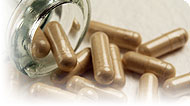Cysteine
Uses
How It Works
How to Use It
Most people do not need to supplement with cysteine. Almost nothing is known about appropriate supplemental levels, in part because almost all clinical research has been done with N-acetyl cysteine and not cysteine itself.
Where to Find It
The body can synthesize cysteine from methionine and other building blocks. Cysteine, the amino acid from which NAC is derived, is found in most high-protein foods.
Possible Deficiencies
According to several studies, blood levels of cysteine and glutathione are low in people infected with HIV.1, 2, 3 Cysteine has a role in the proper function of the immune system, so a deficiency of this amino acid may either contribute to, or result from, immune suppression associated with HIV.
Interactions
Interactions with Supplements, Foods, & Other Compounds
Adequate amounts of methionine are needed in the diet, as the precursor to cysteine, to prevent cysteine deficiency.
Interactions with Medicines
Side Effects
Side Effects
No consistent adverse effects of NAC have been reported in humans. One small study found that daily amounts of 1.2 grams or more could lead to oxidative damage.4 Extremely large amounts of cysteine, the amino acid NAC is derived from, may be toxic to nerve cells in rats.5
References
1. Eck HP, Gander H, Hartmann M, et al. Low concentrations of acid-soluble thiol (cysteine) in the blood plasma of HIV-1 infected patients. Biol Chem Hoppe Seyler 1989;370:101-8.
2. Droge W, Eck HP, Mihm S. HIV-induced cysteine deficiency and T-cell dysfunction—a rationale for treatment with N-acetylcysteine. Immunol Today 1992;13:211-4.
3. Droge W. Cysteine and glutathione deficiency in AIDS patients: a rationale for the treatment with N-acetyl-cysteine. Pharmacology 1993;46:61-5 [review].
4. Kleinveld HA, Demacker PNM, Stalenhoef AFH. Failure of N-acetylcysteine to reduce low-density lipoprotein oxidizability in healthy subjects. Eur J Clin Pharmacol 1992;43:639-42.
5. Olney JW, Ho OL. Brain damage in infant mice following oral intake of glutamate, aspartate or cysteine. Nature 1970;227:609-10 [letter].
Last Review: 03-18-2015

Copyright © 2024 TraceGains, Inc. All rights reserved.
Learn more about TraceGains, the company.
The information presented by TraceGains is for informational purposes only. It is based on scientific studies (human, animal, or in vitro), clinical experience, or traditional usage as cited in each article. The results reported may not necessarily occur in all individuals. For many of the conditions discussed, treatment with prescription or over the counter medication is also available. Consult your doctor, practitioner, and/or pharmacist for any health problem and before using any supplements or before making any changes in prescribed medications. Information expires December 2024.
This information does not replace the advice of a doctor. Healthwise, Incorporated, disclaims any warranty or liability for your use of this information. Your use of this information means that you agree to the Terms of Use. Learn how we develop our content.

